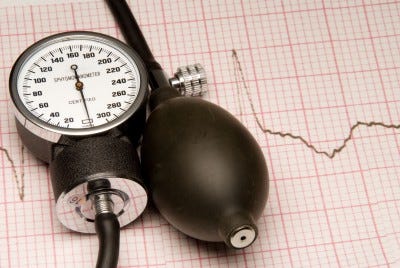Blood pressure cuffs vs arterial lines for hypotensive patients
If you and your team just can't get an arterial line into your critically ill, hypotensive patient for continuous invasive blood pressure measurement, you may be somewhat comforted by a study in Critical Care Medicine. Authors found that among 150 critically ill patients (83 of whom were in shock), mean arterial pressure (MAP) measurements with an arm cuff were highly reliable at detecting clinically relevant hypotension, as compared to invasive BP monitoring with an arterial line. Measurements of MAP at the ankle and thigh were inferior but also accurate for this purpose, depending on one's standard for certainty. However, blood pressure cuff measurements were less precise, frequently varying widely from the results on invasive monitoring.
What They Did
Each of 150 critically ill patients (without known "severe arterial occlusive disease") at a single MICU in Montpellier, France underwent matched measurements of BP with a noninvasive cuff at each site (arm, thigh, ankle) as well as invasive BP measured with an arterial line. In those 83 patients who were in shock during the study period, another set of measurements were taken after an intervention was performed (either volume challenge, or increase in vasopressor dosage). Twenty-one (25% of the patients in shock) had septic shock; the others had hemorrhagic shock, head injuries, or cardiogenic shock.
What They Found
Overall, systolic and diastolic pressures did not correlate well between noninvasive blood pressure cuffs and the arterial lines. This should be unsurprising to anyone who's watched the two measurements vary widely on any given patient in the ICU.
However, the mean arterial pressures (MAPs) correlated fairly well between the arm cuff and the arterial lines: r2 = 0.85. Using Bland-Altman analysis, the mean bias was reasonably low at 3.4 mm Hg (+/- 5 mm Hg). As has been previously demonstrated, a blood pressure cuff at the arm in this series was much more reliable than at the ankle or thigh (r2 = 0.67 and 0.84 respectively, with poor agreement/high bias on Bland-Altman assessment).
An arm blood pressure cuff was far more likely to underestimate MAP/blood pressure than to overestimate it (that's the "mean bias" -- noninvasive arm cuffs underestimated MAP by 3.4 mm Hg on average). Which is the goal, if you're trying to avoid missing the identification of a patient in shock. Perhaps surprisingly, arm cuff performed particularly well at low MAPs in these patients.
For these reasons, arm blood pressure cuff did very well at identifying patients with hypotension: an area-under-the-curve of 0.98, with about 95% sensitivity and specificity overall. Arm cuffs also identified patients who "responded" to cardiovascular intervention (>10% change in MAP after a volume bolus or increase in vasopressors), with an AUC of 0.99.
Ankle and thigh cuffs were inaccurate and unreliable at identifying the actual blood pressure or mean arterial pressure, but they could still be used with some success as a "yes/no" test to identify hypotension. The AUC for both the ankle and thigh cuffs for identifying MAP < 65 mm Hg was 0.93, with high sensitivity (90% for the ankle, 97% for the thigh) and 75-80% specificity.
What It Means
This was a single-center study including less than 100 hypotensive patients (only ~20 of whom had septic shock), and was by its nature unblinded, so consider it far from definitive. Standard practice and published guidelines on sepsis advise placement of an invasive arterial line for continuous blood pressure monitoring in all patients requiring vasopressors "as soon as practical when resources are available (Grade 1D)".
When an arterial catheter isn't feasible for whatever reason (obesity, operator skill, etc.), noninvasive blood pressure cuffs appear to be effective at answering the most important question: whether a patient is hypotensive.
Lakhal K et al. Noninvasive monitoring of blood pressure in the critically ill: Reliability according to the cuff site (arm, thigh, or ankle). Crit Care Med 2012;40:1207-1213).



